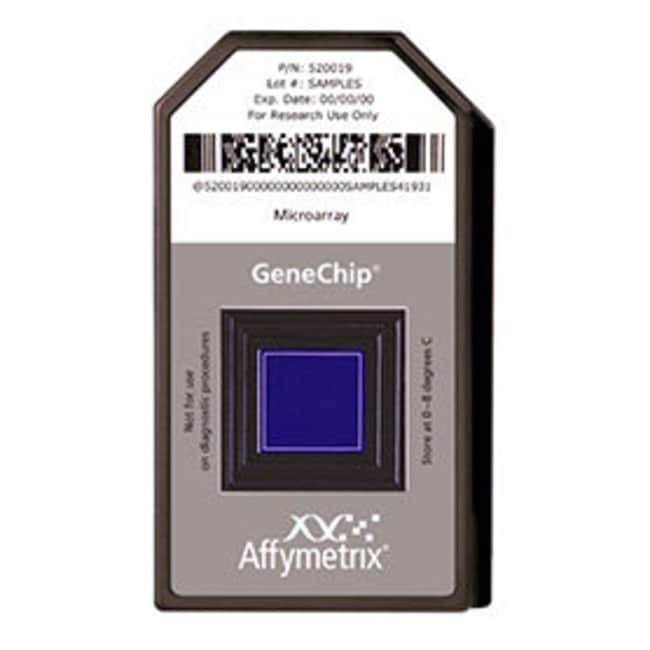Search Thermo Fisher Scientific

Applied Biosystems™
GeneChip™ Mouse Gene 2.0 ST Array
The GeneChip™ Mouse Gene 2.0 ST Array is a whole-transcript array that includes probes to measure both messenger (mRNA) andRead more
| Catalog Number | Number of Arrays |
|---|---|
| 902118 | 6 arrays |
| 902500 | 2 arrays |
| 902119 | 30 arrays |
Catalog number 902118
Price (USD)
3,995.00
Each
In stock
Number of Arrays:
6 arrays
Price (USD)
3,995.00
Each
The GeneChip™ Mouse Gene 2.0 ST Array is a whole-transcript array that includes probes to measure both messenger (mRNA) and long intergenic non-coding RNA transcripts (lincRNA). This whole-transcript array design provides a complete expression profile of mRNA as well as the intermediary lincRNA transcripts that impact the mRNA expression profile.
Since the design of the GeneChip Mouse Gene 1.0 ST Array, there has been a substantial increase in the structural and functional understanding of the mouse genome. This increase in knowledge includes the identification of a large number of long intergenic lincRNA that have been identified by the research community. In order to provide the research community with a tool that can measure the differential expression of this exciting class of RNA transcripts, we designed the GeneChip Mouse Gene 2.0 ST Array. To supplement the lincRNA data contained in RefSeq, we used sequence and transcript data from lncRNA db (http://lncrnadb.com/).
Comprehensive design
Research over the past 20 years has predominantly focused on protein-coding messenger RNA transcripts and their role in cellular processes, such as disease and development. Recently researchers have identified more that 2,000 transcripts (>200 bases) in the mouse genome with little or no protein coding potential. Only a small fraction of these non-coding RNAs has functional annotations to date. However, there is ample evidence that differential expression of lincRNAs plays an important role in the genesis and progression of disease and that aberrant expression of these molecules have also been linked to cancer. Recent advancements in transcriptome profiling provided evidence of the association of lincRNAs in diverse range of cellular functions:
• Regulation of mRNA transcription
• Regulation of mRNA post-transcriptional modifications
• Occlusion/recruitment of transcription factor binding
• Activation and transportation of transcription factors
• Interaction with accessory proteins
• Guide protein complexes to locations in the genome
Key benefits
• Comprehensive coverage provides the best opportunity to discover interesting biology
- >28,000 coding transcripts
- >7,000 non-coding (include ˜2,000) long intergenic non-coding transcripts
• Measure alternative splicing events/transcript variants with probes designed to maximize exon coverage
• Reproducible: Intra-lot correlation coefficient = 0.99
Since the design of the GeneChip Mouse Gene 1.0 ST Array, there has been a substantial increase in the structural and functional understanding of the mouse genome. This increase in knowledge includes the identification of a large number of long intergenic lincRNA that have been identified by the research community. In order to provide the research community with a tool that can measure the differential expression of this exciting class of RNA transcripts, we designed the GeneChip Mouse Gene 2.0 ST Array. To supplement the lincRNA data contained in RefSeq, we used sequence and transcript data from lncRNA db (http://lncrnadb.com/).
Comprehensive design
Research over the past 20 years has predominantly focused on protein-coding messenger RNA transcripts and their role in cellular processes, such as disease and development. Recently researchers have identified more that 2,000 transcripts (>200 bases) in the mouse genome with little or no protein coding potential. Only a small fraction of these non-coding RNAs has functional annotations to date. However, there is ample evidence that differential expression of lincRNAs plays an important role in the genesis and progression of disease and that aberrant expression of these molecules have also been linked to cancer. Recent advancements in transcriptome profiling provided evidence of the association of lincRNAs in diverse range of cellular functions:
• Regulation of mRNA transcription
• Regulation of mRNA post-transcriptional modifications
• Occlusion/recruitment of transcription factor binding
• Activation and transportation of transcription factors
• Interaction with accessory proteins
• Guide protein complexes to locations in the genome
Key benefits
• Comprehensive coverage provides the best opportunity to discover interesting biology
- >28,000 coding transcripts
- >7,000 non-coding (include ˜2,000) long intergenic non-coding transcripts
• Measure alternative splicing events/transcript variants with probes designed to maximize exon coverage
• Reproducible: Intra-lot correlation coefficient = 0.99
For Research Use Only. Not for use in diagnostic procedures.
Specifications
TypeMouse Gene 2.0 ST Array
ArrayTranscriptome Profiling
Number of Arrays6 arrays
FormatArray Cartridge
SpeciesMouse
Product LineGeneChip™
Quantity6 arrays
Unit SizeEach
Have questions about this product? Ask our AI assisted search.
This is an AI-powered search and may not always get things right. You can help us make it better with a thumbs up or down on individual answers or by selecting the “Give feedback" button. Your search history and customer login information may be retained by Thermo Fisher and processed in accordance with our
Privacy Notice.
Frequently asked questions (FAQs)
Figures

Transcript Coverage

Data Source
Customers who viewed this item also viewed
Documents & Downloads
Certificates
Search by lot number or partial lot number
0 results displayed, search above for a specific certificate